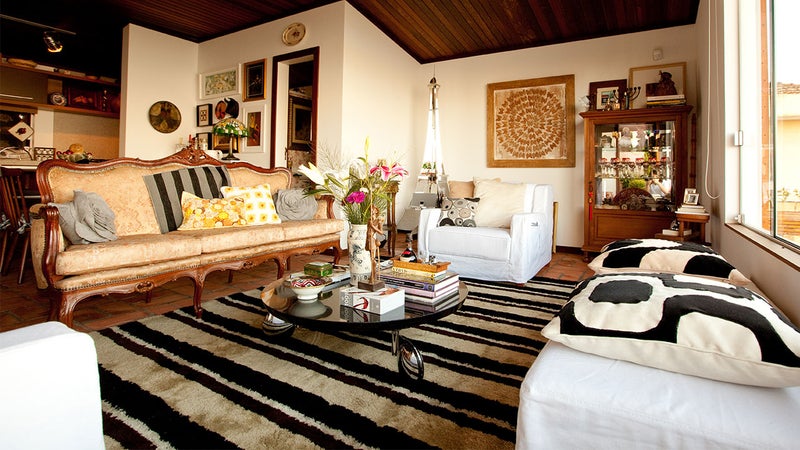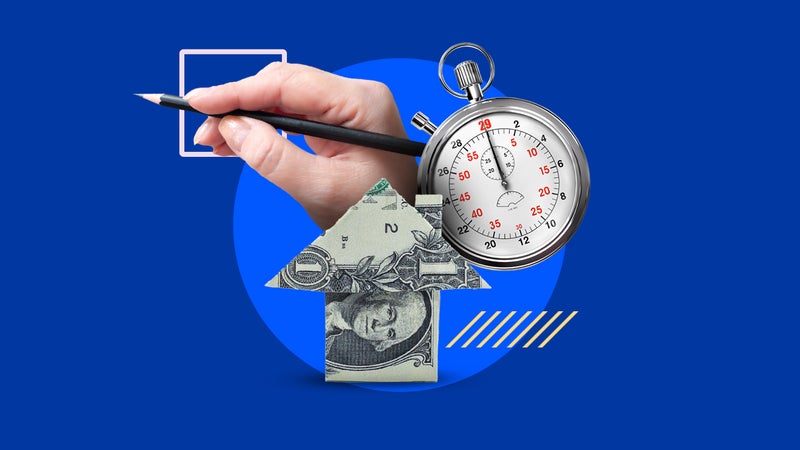How does a fixed-rate HELOC work?

The Bankrate promise
At Bankrate we strive to help you make smarter financial decisions. While we adhere to strict , this post may contain references to products from our partners. Here's an explanation for .
Key takeaways
- The interest rate on fixed-rate HELOCs stays the same throughout the draw period.
- In some cases, you can switch between a fixed-rate and a variable rate on these types of HELOCs to take advantage of lower rates.
- Fixed-rate HELOCs may charge higher fees and come with higher starting interest rates.
You might know how a home equity line of credit (HELOC) works — a revolving line of credit with a variable interest rate, sort of like a credit card. That’s your standard HELOC. But there’s a less common variety: a fixed-rate HELOC, whose interest rate can be locked in — so your payments won’t vary.
Here’s how a fixed-rate HELOC works and how it differs from a traditional home equity line of credit.
What is a fixed-rate HELOC?
If a regular HELOC is akin to a big credit card, a fixed-rate HELOC is similar to a second mortgage. Actually, it’s a hybrid of a home equity loan (which gives you a lump sum at a fixed rate) and a home equity line of credit. It allows you to freeze a portion or all of your balance at a fixed interest rate, protecting you against market fluctuations that impact rates.
With a fixed HELOC, you can withdraw as much or as little of your credit line as needed, just as with a variable-rate HELOC. Unlike a variable-rate HELOC, though, the interest rate on any amount you use will have the same interest rate applied throughout the draw period.
If your HELOC lender offers a fixed-rate option, you can usually do the conversion at closing or during the draw period, says Laura Sterling, vice president of Marketing at Georgia’s Own Credit Union. Locking in a fixed interest rate can provide the stability of predictable monthly payments.
The fixed-rate portion of the HELOC can be locked in for terms ranging from five years to 30 years, during which time the loan is paid back like a typical mortgage, says Joe Perveiler, home lending product executive at PNC Bank.
Pros and cons of a fixed-rate HELOC
As with any financial product, there are both benefits and drawbacks associated with a fixed-rate HELOC. Here are some of the considerations to keep in mind.

Pros of a fixed-rate HELOC
- Avoid interest rate fluctuations
- Stable and predictable repayments
- Potential to lock in interest rate declines

Cons
- May have a higher initial interest rate than a traditional HELOC
- May carry more fees and penalties
- Harder to find: Not all lenders offer fixed-rate HELOCs
Fixed- vs. variable-rate HELOC
A variable-rate HELOC translates to some uncertainty when planning your monthly household budget. A fixed-interest HELOC’s payment can’t fluctuate.
So, what’s the down side? For starters, a HELOC with a fixed rate typically has higher initial interest rates. than traditional HELOCs, says Sterling. You’re paying for the privilege of that potential rate freeze, in other words. Fixed-rate HELOCs might charge higher origination and maintenance fees than comparable traditional HELOCs, too.
Generally, the terms — length of draw period and repayment period — are the same on both types of HELOCs. However, the fixed-rate variety might impose limits on borrowing that you won’t have with a variable-rate HELOC.
What are the typical terms for a fixed-rate HELOC?
Like any home equity loan or line of credit, the interest rate on your fixed-rate HELOC will depend on your credit score and current market rates.
Typically, lenders will let you freeze some or all of the balance on your HELOC at any point during the draw period. They might limit how many times you can lock in a fixed interest rate on your HELOC (for example, US Bank allows customers to have up to three fixed-rate balances at any time). Also, some lenders require a minimum balance (at Bank of America, it’s $5,000) to switch to a fixed interest rate.
Depending on your lender, you might be able to lock the rate yourself through your online account, or you may need to contact a representative to do so.
Factors to consider with a fixed-rate HELOC
Inflation/interest rate moves
In terms of inflation, a fixed-rate HELOC might be the smarter move. That’s because regardless of what happens with the economy, inflation and interest rates, you’ll still have the security of a fixed rate.
Case in point: The Federal Reserve raised its key lending rate throughout 2022 and 2023 in a continued effort to combat inflation. This strategy led to higher interest on variable-rate financial products, including HELOCs — which surpassed 10 percent in late 2023. As of 2024, rates have begun to come down somewhat and the HELOC national average has remained around 9 percent.
Of course, this strategy works best when interest rates are rising. If prevailing market rates drop, however, you might not be able to easily convert back to a variable rate and reduce your payments.
The bottom line: Take your budget and risk tolerance into consideration.
Purpose of the HELOC
A fixed rate can be especially beneficial if you’re using the HELOC to make home improvements. It relieves you of any rush to make draws and begin remodeling before the rate increases.
“Establishing a fixed-rate lock on a HELOC can often make sense when a customer has a planned expense they need to finance, such as a home renovation project,” says Perveiler. “In that scenario, the customer will have full certainty about the cost of their financing.”
A fixed-rate HELOC might also come in handy in an emergency, such as an unforeseen medical bill or to consolidate debt.
Cost and fees
While a fixed-rate HELOC lends certainty to your budget, there’s no telling how interest rates might change in the future. If rates fall, you might find you were better off with a variable-rate line of credit.
There might also be hidden fees, such as penalties for paying the line off early or a fee for exercising the conversion option.
“Borrowers may want to look out for annual fees and rate locks,” says Sterling. “Some lenders cap the number of fixed-rate locks that a borrower can do annually and may charge a fee for each rate lock. Borrowers should also be aware of minimum withdrawal amounts.”
Minimum borrowing requirements
Some lenders require a minimum outstanding balance on the line of credit before you can get the fixed rate. This might not work well for you if you’re trying to stay within a certain budget, forcing you to borrow funds you don’t really need.
They might also restrict how many times you can switch from a variable rate to a fixed one.
Why aren’t all HELOC rates fixed?
The traditional, variable-rate variety has long been the predominant type of HELOC, and it continues to be the most widely offered. The interest rate on traditional HELOCs changes with the fluctuations in other interest rates, including the benchmark rate set by the Federal Reserve.
However, fixed-rate offerings are becoming more common as lenders look for ways to help consumers save money when borrowing amid the soaring-interest-rate environment of the last two years. Fixed-rate HELOCs offer protection in such climates. That was mortgage lender Guaranteed Rate’s thinking in adding a fixed-rate HELOC to its product line in 2022.
Can I convert an existing HELOC to a fixed rate?
If you’ve taken out a variable-rate HELOC and want to convert to a fixed rate, there are a couple ways to go about it:
- Open a new HELOC. The simplest way to get a fixed-rate HELOC is to take out a new HELOC altogether — a fixed-rate one or a hybrid that lets you convert. This strategy is best if you’re near the end of the draw period for your current HELOC.
- Refinance your old HELOC. If you open up a new hybrid HELOC, you can use it to refinance your existing HELOC — you’ll simply pay off the balance of your old HELOC using funds from your new line of credit. This will also reset your draw period. For example, Bethpage Federal Credit Union offers the unique option to convert some or all of a variable-rate HELOC to a fixed-rate loan without a fee; you can choose between five-, 10- and 20- year repayment terms.
Can I convert a fixed-rate HELOC to a variable-rate HELOC if rates drop?
When interest rates drop, a variable-rate HELOC might be tempting — and indeed, more financially beneficial than a fixed-rate one. If you’ve already converted your variable rate to fixed, “some lenders may allow the borrower to convert back to a variable rate” later on, says Sterling. The ability to switch back and forth between variable and fixed rates allows you to take advantage of lower interest rates when they become available.
If not, plan B could be a refinance of the HELOC.
Is a fixed-rate HELOC best for me?
Whether it’s a home renovation project or a large unexpected expense, it’s a good idea to examine both variable-rate and fixed-rate HELOC options carefully to determine which one makes sense for you. Both have their benefits; it’s just a matter of your needs. Here are some questions to ask:
- What’s the interest rate environment? “If you are in a rising rate market, a fixed-rate HELOC could be a good option,” says Sterling. “If you anticipate rates remaining low, you may save more with a traditional HELOC.”
- Is there a set amount you need to borrow? Are you paying off a student loan or financing a large or ongoing home improvement project? Fixed-rate HELOCs might give you more flexibility; however, some lenders require that you borrow a minimum amount to lock in the rate.
- Are you comfortable with payments that could change over time? “If the answer is no, a fixed-rate HELOC could be a good choice,” says Sterling. If yes, a traditional variable-rate HELOC will work just fine — just be sure to budget for big jumps, especially when your repayment period begins.
FAQ
-
There are several steps required to convert an existing HELOC to a fixed-rate HELOC. Initially, homeowners should contact their lender to express interest in a conversion, says Alexander Suslov, head of capital markets for AD Mortgage. “The lender will then assess eligibility based on factors such as the current balance, loan-to-value ratio, and credit score,” says Suslov. “Depending on the lender, borrowers may convert a portion or the entire HELOC balance to a fixed-rate loan, with various fixed-rate options available.”This process may also involve fees such as application fees, appraisal fees and possibly a new title search, though some lenders might waive certain charges. Borrowers will also be required to sign new loan documents outlining the terms of the conversion, including the interest rate, monthly payment and repayment schedule. Some lenders may also impose minimum and maximum limits on the amount that can be converted to a fixed HELOC, typically with a minimum amount around $5,000, says Suslov.
-
A fixed-rate HELOC and a home equity loan share several similarities. Both are secured by the equity of your property and can be used for similar purposes, such as home improvements or debt consolidation. Both also typically offer lower interest rates compared to unsecured loans, says Suslov. However, a fixed-rate HELOC starts as a revolving line of credit with a variable interest rate that can later be converted to a fixed rate for a portion of the balance. A home equity loan on the other hand, provides a lump sum of money that’s repaid in installments with a fixed interest rate from the beginning.
“A fixed-rate HELOC may feature variable payments during the initial draw period and fixed payments after conversion,” says Suslov. “Additionally, HELOCs offer greater flexibility since homeowners can borrow as needed during the draw period, unlike home equity loans that disburse a one-time lump sum.”
-
Conversions are typically permitted during a HELOC’s draw period, which usually lasts 5 to 10 years, depending on the HELOC’s terms. Specific timing and conditions for conversion can vary by lender, however, with some allowing conversion at any time during the draw period and others having specific windows or requiring a certain amount of time to pass after the HELOC’s inception, says Suslov. “Additionally, some lenders may mandate a minimum amount to be converted to a fixed rate, often starting around $5,000,” says Suslov.




